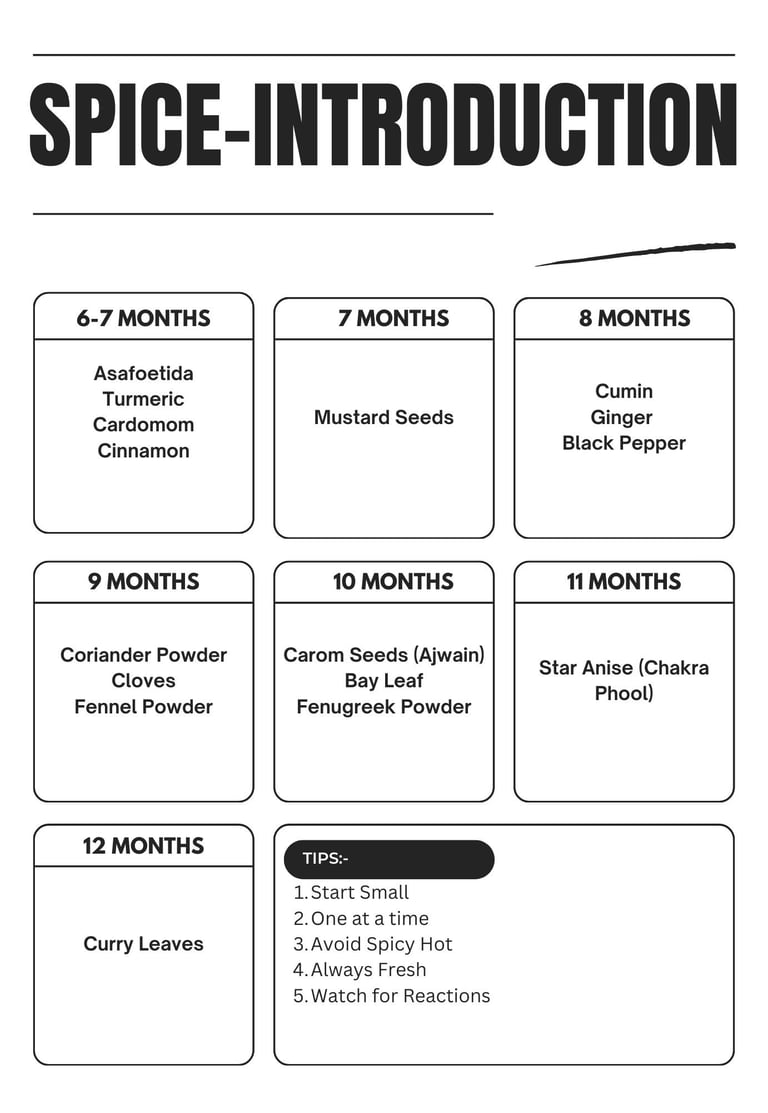Spice Introduction for Babies: A Month-by-Month Guide
Introducing spices to your baby's diet is a beautiful way to expand their palate and boost their health naturally. 🌟 Our month-by-month guide makes it easy for parents to introduce age-appropriate spices like turmeric, cumin, and cinnamon safely. Discover how each spice adds flavor, supports digestion, and contributes to your baby's overall development. Perfect for parents looking to create exciting, nutritious meals for their little ones! 💛
RECIPES
Swati Jain
1/13/20252 min read


Introducing spices to babies is an exciting milestone in their food journey. Not only does it add variety to their diet, but it also helps in developing their palate, enhancing digestion, and promoting overall health. However, this process must be gradual, careful, and aligned with the baby's age and tolerance levels. Here's a detailed guide to introducing spices to your baby, as depicted in the chart above.
6-7 Months
At this stage, babies are just beginning their journey into solid foods. Gentle and aromatic spices are ideal as they are easy to digest and mild in flavor:
Asafoetida (Hing): Known for its digestive properties, a pinch can be added to dal or vegetables.
Turmeric: A natural anti-inflammatory spice, turmeric is perfect for soups or porridges.
Cardamom: Adds a sweet and fragrant note to baby food, aiding digestion.
Cinnamon: A mild spice that complements fruits like apples or pears.
7 Months
As your baby becomes more familiar with new tastes, you can introduce:
Mustard Seeds: Often tempered and added to soups or stews for a mild flavor boost.
8 Months
The palate begins to expand, and slightly stronger spices can be introduced:
Cumin: A digestive aid that works well in lentils and vegetables.
Ginger: Offers anti-inflammatory benefits; use sparingly in soups.
Black Pepper: A pinch can enhance flavor without overwhelming the baby’s taste buds.
9 Months
This is the perfect time to start incorporating aromatic spices:
Coriander Powder: Adds a subtle earthy flavor to baby’s meals.
Cloves: A warm spice that supports digestion, best used in soups.
Fennel Powder: Sweet and soothing, fennel powder can be used in porridge or milk.
10 Months
Introduce spices that are slightly more intense in flavor:
Carom Seeds (Ajwain): Great for digestion, especially in flatbreads or soups.
Bay Leaf: Use while cooking rice or stews and remove before serving.
Fenugreek Powder: Known for its health benefits, it can be added in small amounts to soups.
11 Months
Now, you can introduce bolder spices in moderation:
Star Anise (Chakra Phool): Adds a mild licorice flavor to soups and rice dishes.
12 Months
By the time your baby reaches their first birthday, they are ready for:
Curry Leaves: A fragrant addition to dals and stews, enhancing flavor and nutrition.
Tips for Introducing Spices
Start Small: Begin with tiny amounts to avoid overwhelming your baby.
Introduce One at a Time: Allow 3-4 days between introducing new spices to watch for reactions.
Avoid Spicy Hot: Stick to mild spices to ensure your baby’s comfort.
Use Fresh Ingredients: Always use fresh spices for the best flavor and health benefits.
Monitor Reactions: Look out for any signs of allergies or discomfort.
Why Introduce Spices?
Introducing spices early helps to:
Enhance the flavor profile of meals.
Improve digestion with natural ingredients.
Lay the foundation for adventurous eating habits.
Spices not only enrich your baby's food but also their overall growth and development. Remember, every baby is different—what works for one may not suit another. With patience and observation, you’ll be able to craft a flavorful and nutritious diet for your little one.
